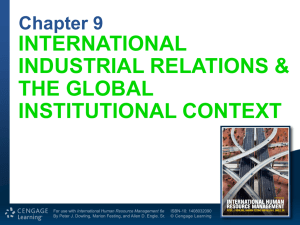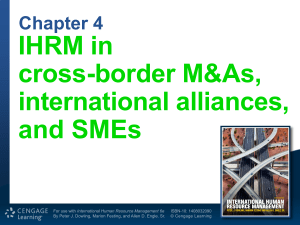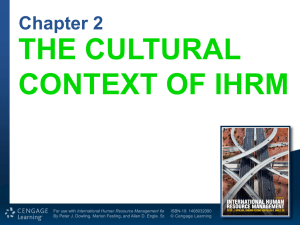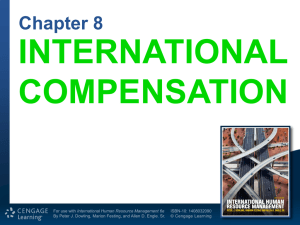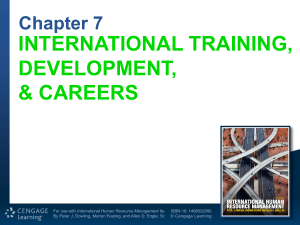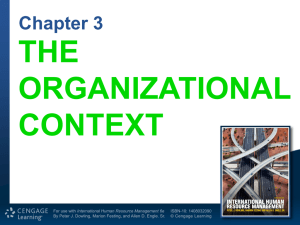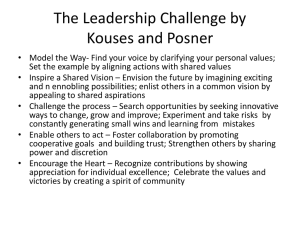Chapter 5
advertisement
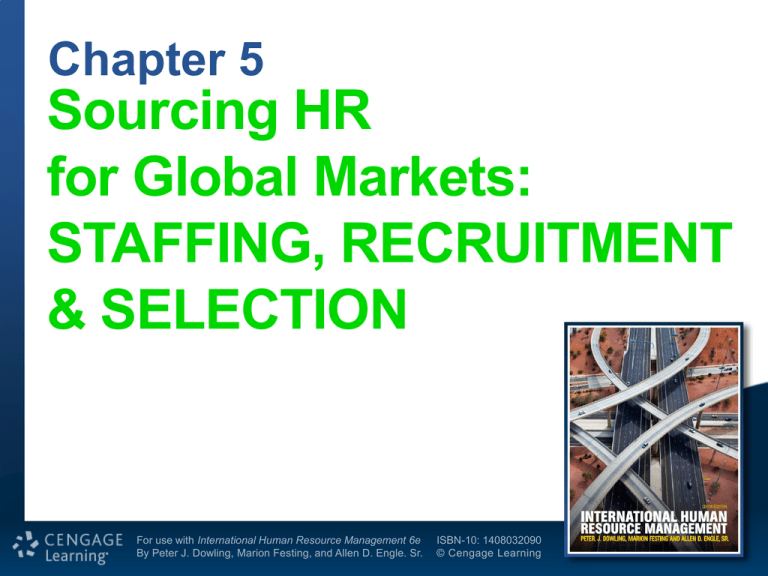
Chapter 5 For use with International Human Resource Management 6e By Peter J. Dowling, Marion Festing, and Allen D. Engle. Sr. ISBN-10: 1408032090 © Cengage Learning 1 of 36 Chapter 5 Sourcing HR for Global Markets: STAFFING, RECRUITMENT & SELECTION START Chapter 5 Click on an item to go to its section. Sourcing HR for Global Markets: STAFFING, RECRUITMENT & SELECTION Vocabulary Objectives Introduction Approaches to staffing Transferring staff for international activities Roles of an expatriate Role of non-expatriates Role of inpatriates Recruitment & selection of international managers Expatriate failure & success Selection criteria Expatriate selection processes in practice Dual career couples For use with International Human Resource Management 6e By Peter J. Dowling, Marion Festing, and Allen D. Engle. Sr. ISBN-10: 1408032090 © Cengage Learning 2 of 36 Chapter 5 Click on the book cover below to return to this table of contents. ethnocentric, polycentric, geocentric, regiocentric Kinds of assignments: short-term, extended, long-term = traditional expatriate assignment, commuter, rotational, contractual, virtual, self-initiated Expatriate roles: language node, agent of direct control, agent of socializing, network builder, transferer of competence & knowledge, boundary spanner best practice tacitness inpatriates, external recruits internal recruitment, headhunting expatriate failure, EFRs, direct & indirect costs selection criteria, soft skills, intercultural competence, cultural intelligence, common corporate language honeymoon = tourist phase coffee-machine system ethnorelativism For use with International Human Resource Management 6e By Peter J. Dowling, Marion Festing, and Allen D. Engle. Sr. ISBN-10: 1408032090 © Cengage Learning 3 of 36 Chapter 5 Vocabulary Objectives We learn foundations of ‘managing people’ in IHRM: 1. Issues related to approaches to staffing foreign ops. 2. Reasons for international assignments 3. Types of international assignments 4. Expatriate & non-expatriate roles in supporting international business activities 5. Debate about expatriate failure, selection criteria, & gender in IHRM For use with International Human Resource Management 6e By Peter J. Dowling, Marion Festing, and Allen D. Engle. Sr. ISBN-10: 1408032090 © Cengage Learning 4 of 36 Chapter 5 Then we learn about IHRM recruitment & selection: For use with International Human Resource Management 6e By Peter J. Dowling, Marion Festing, and Allen D. Engle. Sr. ISBN-10: 1408032090 © Cengage Learning 5 of 36 Chapter 5 Introduction This chapter Examines various approaches to international staffing Outlines pivotal role of international assignments For use with International Human Resource Management 6e By Peter J. Dowling, Marion Festing, and Allen D. Engle. Sr. ISBN-10: 1408032090 © Cengage Learning 6 of 36 Chapter 5 Focuses on recruitment & selection as major factors in success of global assignments For use with International Human Resource Management 6e By Peter J. Dowling, Marion Festing, and Allen D. Engle. Sr. ISBN-10: 1408032090 © Cengage Learning 7 of 36 Chapter 5 Approaches to staffing Staffing attitudes of internationalizing firms For use with International Human Resource Management 6e By Peter J. Dowling, Marion Festing, and Allen D. Engle. Sr. ISBN-10: 1408032090 © Cengage Learning 8 of 36 Chapter 5 Ethnocentric – PCNs are favored Polycentric – HCNs manage subsidiaries Geocentric – Ability is more important than nationality Regiocentric – Similar to geocentric, but limited to a given region For use with International Human Resource Management 6e By Peter J. Dowling, Marion Festing, and Allen D. Engle. Sr. ISBN-10: 1408032090 © Cengage Learning 9 of 36 Chapter 5 Table 5.1a Advantages & disadvantages of using PCNs For use with International Human Resource Management 6e By Peter J. Dowling, Marion Festing, and Allen D. Engle. Sr. ISBN-10: 1408032090 © Cengage Learning 10 of 36 Chapter 5 Table 5.1b Advantages & disadvantages of using TCNs For use with International Human Resource Management 6e By Peter J. Dowling, Marion Festing, and Allen D. Engle. Sr. ISBN-10: 1408032090 © Cengage Learning 11 of 36 Chapter 5 Table 5.1c Advantages & disadvantages of using HCNs For use with International Human Resource Management 6e By Peter J. Dowling, Marion Festing, and Allen D. Engle. Sr. ISBN-10: 1408032090 © Cengage Learning 12 of 36 Chapter 5 Figure 5.1 Determinants of staffing choices For use with International Human Resource Management 6e By Peter J. Dowling, Marion Festing, and Allen D. Engle. Sr. ISBN-10: 1408032090 © Cengage Learning 13 of 36 Chapter 5 Transferring staff for international activities Reasons for international assignments Position filling lack of available skills PCN works abroad Management development - training, development, common corp. values For use with International Human Resource Management 6e By Peter J. Dowling, Marion Festing, and Allen D. Engle. Sr. ISBN-10: 1408032090 © Cengage Learning 14 of 36 Chapter 5 Organization development - transfer of knowledge, competence, practices - exploit global market opportunities Types of international assignments Short term up to 3 months Extended up to 1year Long term 1 to 5 years (traditional expatriate assignment) For use with International Human Resource Management 6e By Peter J. Dowling, Marion Festing, and Allen D. Engle. Sr. ISBN-10: 1408032090 © Cengage Learning 15 of 36 Chapter 5 Some non-standard assignments: Commuter go home every one to two weeks Rotational commute for set period followed by break in home country Contractual specific skills employees hired for 6-12 months on specific projects Virtual employee manages international responsibilities from base in home country For use with International Human Resource Management 6e By Peter J. Dowling, Marion Festing, and Allen D. Engle. Sr. ISBN-10: 1408032090 © Cengage Learning 16 of 36 Chapter 5 Table 5.2 Differences between traditional & short-term assignments For use with International Human Resource Management 6e By Peter J. Dowling, Marion Festing, and Allen D. Engle. Sr. ISBN-10: 1408032090 © Cengage Learning 17 of 36 Chapter 5 Roles of an expatriate For use with International Human Resource Management 6e By Peter J. Dowling, Marion Festing, and Allen D. Engle. Sr. ISBN-10: 1408032090 © Cengage Learning 18 of 36 Chapter 5 Figure 5.2 Determinants of staffing choices Open environment » Support for cross-fertilization of ideas » Implementation of best practice Knowledge/info travels freely between expatriate, host country, & parent country Consideration for personal networks Some knowledge transfer requires longer assignments (e.g., where there is much tacitness) Expatriate’s ability & motivation to act as an agent of knowledge transfer Abilities, motivations, relationships of locals For use with International Human Resource Management 6e By Peter J. Dowling, Marion Festing, and Allen D. Engle. Sr. ISBN-10: 1408032090 © Cengage Learning 19 of 36 Chapter 5 Factors that influence effectiveness of international assignments For use with International Human Resource Management 6e By Peter J. Dowling, Marion Festing, and Allen D. Engle. Sr. ISBN-10: 1408032090 © Cengage Learning 20 of 36 Chapter 5 Role of non-expatriates Issues with international business travelers Home & family issues Work arrangements Travel logistics Health concerns Host culture issues For use with International Human Resource Management 6e By Peter J. Dowling, Marion Festing, and Allen D. Engle. Sr. ISBN-10: 1408032090 © Cengage Learning 21 of 36 Chapter 5 For use with International Human Resource Management 6e By Peter J. Dowling, Marion Festing, and Allen D. Engle. Sr. ISBN-10: 1408032090 © Cengage Learning 22 of 36 Chapter 5 Role of inpatriates Drivers for recruiting & transferring inpatriate mgrs. Desire to create global core competency & cultural diversity of strategic perspectives The emergence of developing markets which often are difficult locations for expatriates: » Quality of life adjustment » Cultural adjustment For use with International Human Resource Management 6e By Peter J. Dowling, Marion Festing, and Allen D. Engle. Sr. ISBN-10: 1408032090 © Cengage Learning 23 of 36 Chapter 5 Desire to provide career opportunities in HCs For use with International Human Resource Management 6e By Peter J. Dowling, Marion Festing, and Allen D. Engle. Sr. ISBN-10: 1408032090 © Cengage Learning 24 of 36 Chapter 5 Recruitment & selection of international managers International vs. domestic recruitment & selection Smaller number of external recruits For use with International Human Resource Management 6e By Peter J. Dowling, Marion Festing, and Allen D. Engle. Sr. ISBN-10: 1408032090 © Cengage Learning 25 of 36 Chapter 5 Preference for internal recruitment » To reduce selection risk » To secure present & past human capital investments For use with International Human Resource Management 6e By Peter J. Dowling, Marion Festing, and Allen D. Engle. Sr. ISBN-10: 1408032090 © Cengage Learning 26 of 36 Chapter 5 Expatriate failure & success For use with International Human Resource Management 6e By Peter J. Dowling, Marion Festing, and Allen D. Engle. Sr. ISBN-10: 1408032090 © Cengage Learning 27 of 36 Chapter 5 Table 5.3 Expatriate failure rates For use with International Human Resource Management 6e By Peter J. Dowling, Marion Festing, and Allen D. Engle. Sr. ISBN-10: 1408032090 © Cengage Learning 28 of 36 Chapter 5 Selection criteria For use with International Human Resource Management 6e By Peter J. Dowling, Marion Festing, and Allen D. Engle. Sr. ISBN-10: 1408032090 © Cengage Learning 29 of 36 Chapter 5 Figure 5.3 Factors in expatriate selection For use with International Human Resource Management 6e By Peter J. Dowling, Marion Festing, and Allen D. Engle. Sr. ISBN-10: 1408032090 © Cengage Learning 30 of 36 Chapter 5 Figure 5.4 Overview of important adjustment variables For use with International Human Resource Management 6e By Peter J. Dowling, Marion Festing, and Allen D. Engle. Sr. ISBN-10: 1408032090 © Cengage Learning 31 of 36 Chapter 5 Expatriate selection processes in practice For use with International Human Resource Management 6e By Peter J. Dowling, Marion Festing, and Allen D. Engle. Sr. ISBN-10: 1408032090 © Cengage Learning 32 of 36 Chapter 5 Table 5.4 Tasks & exercises used in an assessment center For use with International Human Resource Management 6e By Peter J. Dowling, Marion Festing, and Allen D. Engle. Sr. ISBN-10: 1408032090 © Cengage Learning 33 of 36 Chapter 5 Table 5.5 Evaluation scheme for a role play in an intercultural assessment center For use with International Human Resource Management 6e By Peter J. Dowling, Marion Festing, and Allen D. Engle. Sr. ISBN-10: 1408032090 © Cengage Learning 34 of 36 Chapter 5 Dual career couples IHRM solutions for dual career couples Language training, educational assistance Employer-sponsored work permits Career planning assistance For use with International Human Resource Management 6e By Peter J. Dowling, Marion Festing, and Allen D. Engle. Sr. ISBN-10: 1408032090 © Cengage Learning 35 of 36 Chapter 5 Inter-firm networking Job-hunting assistance Intra-firm employment For use with International Human Resource Management 6e By Peter J. Dowling, Marion Festing, and Allen D. Engle. Sr. ISBN-10: 1408032090 © Cengage Learning 36 of 36 Chapter 5 Table 5.6 Strategies for breaking the expatriate glass ceiling
